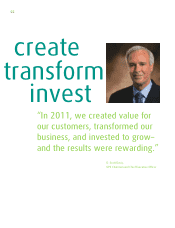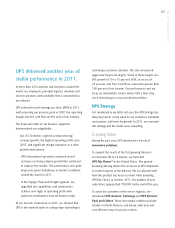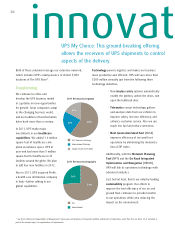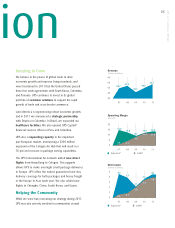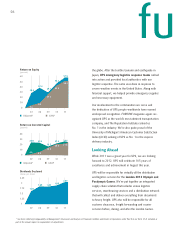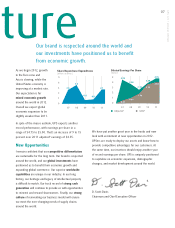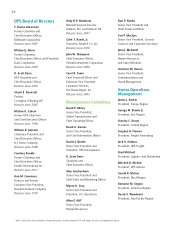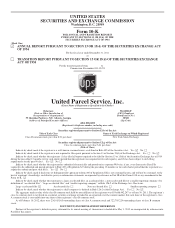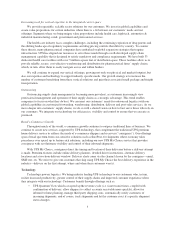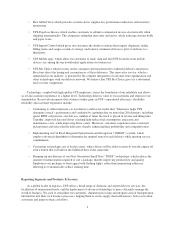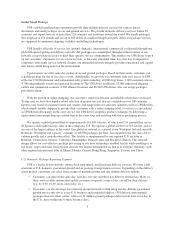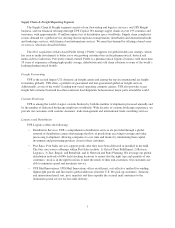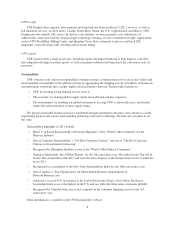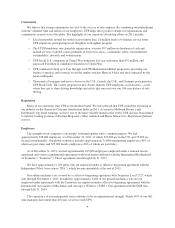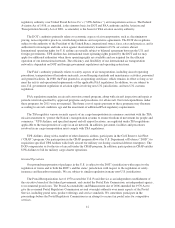UPS 2011 Annual Report Download - page 14
Download and view the complete annual report
Please find page 14 of the 2011 UPS annual report below. You can navigate through the pages in the report by either clicking on the pages listed below, or by using the keyword search tool below to find specific information within the annual report.enables our customers to bridge time zones, cultures, distances and languages to keep the entire supply chain
moving smoothly. We operate approximately 800 logistics facilities, in more than 120 countries, offering
warehouse space of 35 million square feet.
We serve the global market for logistics services, which include transportation, distribution, forwarding,
ground, ocean and air freight, brokerage and financing. Our technology seamlessly binds our service portfolio.
We have three reportable segments: U.S. Domestic Package, International Package and Supply Chain & Freight,
all of which are described below. For financial information concerning our reportable segments and geographic
regions, refer to note 12 of our consolidated financial statements.
Business Strategy
Customers leverage our broad array of services; balanced global presence in North America, Europe, Asia
and Latin America; reliability; and industry leading technology for competitive advantage in markets where they
choose to compete. We prudently invest to expand our integrated network and our service portfolio. Technology
investments create user-friendly shipping, e-commerce, logistics management and visibility tools for our
customers, while supporting UPS’s ongoing efforts to increase operational efficiencies.
Our service portfolio and investments are rewarded with among the best returns on invested capital and
operating margins in the industry. We have a long history of sound financial management. Our balance sheet
reflects financial strength that few companies can match. As of December 31, 2011, we had a balance of cash and
marketable securities of approximately $4.275 billion and shareowners’ equity of $7.108 billion. Our Moody’s
and Standard & Poor’s short-term credit ratings are P-1 and A-1+, respectively, and our Moody’s and Standard &
Poor’s long-term credit ratings are Aa3 and AA-, respectively. We have a stable outlook from both of these credit
rating agencies. Cash generation is a significant strength of UPS. This gives us strong capacity to service our
obligations and allows for distributions to shareowners, reinvestment in our businesses and the pursuit of growth
opportunities.
We enable and are the beneficiaries of the following trends:
Expansion of Global Trade
Trade across borders is predicted to grow at rates that are at least double the growth rates of U.S. and global
domestic production for the foreseeable future. As a result, U.S. and international economies are becoming more
inter-connected and dependent on foreign trade.
UPS plays an important role in global trade and is uniquely positioned to take advantage of trade growth,
wherever it emerges. Our balanced global presence and productivity enhancing technologies allow customers to
effortlessly expand to new markets. We advocate the expansion of free trade, including the passage of regional
trade pacts and the removal of trade barriers. Free trade is a catalyst for job creation, economic growth and
improved living standards; additionally, it propels our growth.
Emerging Market Growth
As our current and prospective customers seek growth outside of developed markets, they look to emerging
markets for expansion. We make long-term, measured investments in markets where our customers choose to
grow. Our investments are scaled to the local opportunity. We typically follow a pattern of entering a market
through importing and exporting, expanding domestically with a partner or alliance, and then ultimately
acquiring domestic operations where we see value and return. China is a prime example of this strategy as we
continue to clear hurdles that will enable us to realize this vision. Our two key air hubs in Shanghai and Shenzhen
support market expansion through increased cargo capacity and faster intra-Asia transit times, while enabling our
customers to ship later in the day. We link Asia to Europe with overnight flights from Hong Kong through our air
hub in Cologne, Germany.
Taken together, these two trends (expanding global trade and emerging market growth) underscore why our
international business is a catalyst for UPS’s growth.
2


